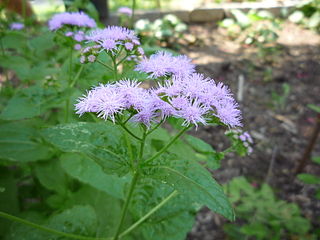Harold Ernest Robinson was an American botanist and entomologist.

Liatris, commonly known as gayfeather and blazing star is a genus of flowering plants in the tribe Eupatorieae within the family Asteraceae native to North America. Some species are used as ornamental plants, sometimes in flower bouquets. They are perennials, surviving the winter and resprouting underground corms.

Eupatorium is a genus of flowering plants in the family Asteraceae, containing from 36 to 60 species depending on the classification system. Most are herbaceous perennials growing to 0.5–3 m (1.6–9.8 ft) tall. A few are shrubs. The genus is native to temperate regions of the Northern Hemisphere. Most are commonly called bonesets, thoroughworts or snakeroots in North America. The genus is named for Mithridates Eupator, king of Pontus.

Eupatorieae is a tribe of over 2000 species of plants in the family Asteraceae. Most of the species are native to tropical, subtropical, and warm temperate areas of the Americas, but some are found elsewhere. Well-known members are Stevia rebaudiana, a number of medicinal plants (Eupatorium), and a variety of late summer to autumn blooming garden flowers, including Ageratum (flossflower), Conoclinium (mistflower), and Liatris.

Conoclinium, the mistflowers, is a genus of four species of herbaceous perennial flowering plants, native to North America. They are 0.5 to 2 metres tall, and have blue to purple or violet flowers.
Flyriella is a genus of perennial flowering plants in the family Asteraceae, and the species are commonly called brickellbush. They are native to Texas and Mexico.

Ageratina havanensis, the Havana snakeroot or white mistflower, is a species of flowering shrub in the family Asteraceae, native to the south-western United States (Texas), Cuba, and north-eastern and east-central Mexico. Unlike many other species of Ageratina, it is evergreen.
Isocarpha (pearlhead) is a genus of flowering plants in the family Asteraceae. They are native to Mexico, Central America, the West Indies, and northern South America, with the range of one species extending north into the United States.
Sclerolepis is an aquatic plant native to the eastern United States. It has only one known species, Sclerolepis uniflora, the pink bogbutton. It lives in ponds and other wet areas. When water is abundant, the plant lives underwater, with long stems and flaccid, elongated leaves, and does not flower. When the water level drops, it assumes a form more familiar in terrestrial plants, with an erect stem, and flowers in summer to fall. The flowers are pink.

Shinnersia rivularis, known as the Rio Grande bugheal or Mexican oak leaf plant, is an aquatic plant native to Texas, Coahuila, and Nuevo León.
Trichocoronis is a genus of North American aquatic plants in the tribe Eupatorieae within the family Asteraceae. Bugheal is a common name for plants in this genus.
Asanthus is a small genus of flowering plants in the family Asteraceae, found only in northern Mexico and the southwestern United States.
Brickelliastrum is a North American genus of flowering plants in the tribe Eupatorieae within the family Asteraceae. Brickelliastrum has at times been lumped with Brickellia or Steviopsis, but chromosome number (x=10) and molecular data are in agreement in showing that it is distinct from either of these. Despite having the general appearance of Brickellia, members of Brickelliastrum have cypselae that have only 5-7 ribs (vs. 10), funnel-shaped corollas, and a style with an unenlarged, glabrous base.

Peteravenia is a genus of Mesoamerican plants in the tribe Eupatorieae within the family Asteraceae.
Asanthus squamulosus is a North American species of plants in the family Asteraceae. It is native to northern Mexico, and the southwestern United States. Common name is Mule Mountain false brickellbush.
Brickellia laciniata, the splitleaf brickellbush, is a North American species of flowering plants in the family Asteraceae. It is native to northeastern and north-central Mexico and the southwestern United States.
Chromolaena bigelovii called Bigelow's false thoroughwort, or Bigelow's thoroughwort, is a North American species of flowering shrub in the family Asteraceae. It is native to northeastern Mexico and the US State of Texas.

Fleischmannia incarnata, the pink slender-thoroughwort or pink thoroughwort, is a North American species of flowering plant in the family Asteraceae. It is native to the United States from Florida north as far as Virginia, Ohio, and Illinois, and west to Texas and Oklahoma. It is also found in northeastern Mexico.
Fleischmannia sonorae, the Sonoran slender-thoroughwort or Sonoran thoroughwort, is a North American species of flowering plant in the family Asteraceae. It is native to western Mexico from Sonora and Chihuahua as far south as Michoacán, as well as from the southwestern United States.
Flyriella parryi, the Chisos Mountain brickellbush, is a Mexican species of plants in the family Asteraceae. It is native to the states of Nuevo León, Coahuila, and Chihuahua in northern Mexico. It is the only species in its genus to have a natural range extending north of the international border, with a few populations on the Texas side of the Río Grande.








